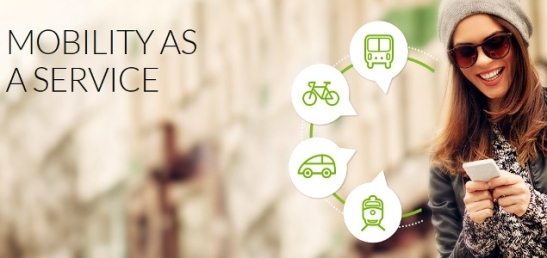Renilde Becqué
A search for compelling sustainability narratives, transformative business models and pathways towards a circular & regenerative economy — www.linkedin.com/in/renildebecque
Mobility as a Service – charting the road for customized on-demand mobility
This article was published on Sustainable Brands in February 2016, exploring how MaaS holds the potential to disrupt and converge the transport sector.
To serve people’s urban mobility needs, cities rely on anything from one dominant, mainly private owned means of transport –the personal automobile – to a complex mixture of publicly and privately financed transport means. Consumers of these mobility services are usually left to their own devices to identify the optimum (combination of) modes to cover a journey and understand differences in terms of pricing, time and convenience.
Traditionally, the public transport sector has focused on providing relatively inflexible services through a ‘take it or leave it’ model with an established but limited range of transport modes on offer. For those whose needs are not met by public transport, mobility often depends to a great extent on car ownership. In Europe for instance 83% of land-based passenger-kilometres are met by cars. The particular set of circumstances in the transport sector such as cost and complexity of entry, incumbent economies of scale, and the regulatory environment have also long helped it avoid major change.
Several key technological developments however, such as the rise of mobile broadband, widespread dissemination of smartphones, big data, and advances in electric vehicles and autonomous driving are now acting as enablers for the emergence of a new mobility model known as Mobility as a Service (MaaS). Various megatrends including rapid urbanisation and the sharing economy help further fuel the nascent disruption of the transport sector.
MaaS is a mobility distribution model which considers all transport modes as one co-operative, interconnected ecosystem. Under MaaS, consumers’ day-to-day mobility needs are met via one unified online interface, offered through a dedicated service provider. The starting point of a journey is therewith not a map or timetable but the point-to-point trip the customer seeks to make, whenever and wherever that may be. This in turn leads to a much more dynamic, flexible and customer-centred means of providing on-demand mobility.
MaaS platforms of the near future are anticipated to typically offer monthly (targeted or customised) subscription packages, somewhat similar to mobile phone plans, whereby users pay a monthly fee to get access to e.g. unlimited travel on urban public transport plus a capped amount of other transport services; as well as Pay-as-you-go (PAYG) options, whereby the MaaS interface would act more like flight search engines, drawing providers into one system to readily provide the user with all options available and allowing instant single payment.
MaaS therewith offers a one-stop-shop client interface, delivered through a highly integrated service system beyond what is commonplace today and bringing collaborative customization to the transport market. Evidenced by the growth in e.g. bike and car sharing and on-demand bus services, the further personalisation and customisation of transport is likely to see a flood of such platforms emerge in years to come.

Although MaaS is foremost about putting the customer in control, it also helps optimize current and emerging transport services. Traditional modes easily lock-in long-term (sometimes unsustainable) travel behaviours, while demand changes and network / infrastructure disruption cannot rapidly be coped with on the supply side. Integrated, interactive transport services can help match customers with live network performance and capacity but according to their individual preferences.
As the uptake of MaaS accelerates, a distinction will emerge between customer-facing transport services and actual providers of transport, versus the current chasm between private and public transport. Urban planning practices will shift to favour smart, compact footprints, while excess transport infrastructure can be repurposed accommodating urban ‘growth within’. Service based business models and high rates of vehicle utilisation are also argued to lead to a decoupling between transport use and its resource footprint.
For currently well-connected cities introducing MaaS might mainly be a matter of integrating existing systems and building an overarching user platform; for others a range of new or emerging transport modes and related soft and hard infrastructure will have to be built out in order to provide sufficient functionality and flexibility of door-to-door transport. Although these transitions may result in high transaction costs, it can also create opportunities to truly connect transport to other city systems and services, such as energy and health, turning transport into an integrated component of a smart, connected and resource efficient city.
With MaaS poised to disrupt the urban transport sector, one may ask whether car manufacturers –busy preparing for the arrival of autonomous vehicles- are overlooking how it could also radically overturn their business model. As data eclipses horsepower and new taxi and car sharing services take off, MaaS could be the key integrating factor which personalizes mass and collaborative transit. This could even culminate in car manufacturers to stop selling cars to individual customers altogether and instead establish or sell their vehicles to ‘pooling’ entities, which on-sell the services to individual customers. The vehicle therewith becomes the next mobile device, competing on shape, function and connectivity to deliver optimized services for meeting the needs of different consumer groups.
One thing is clear though, whether innovative or just integrative, the MaaS interface is part of an ecosystem of emerging and evolving forces revolutionizing the transport sector, whereby its sum is greater than the parts, ensuring tomorrow’s transport is bound to keep us moving at the highest convenience and efficiency.

